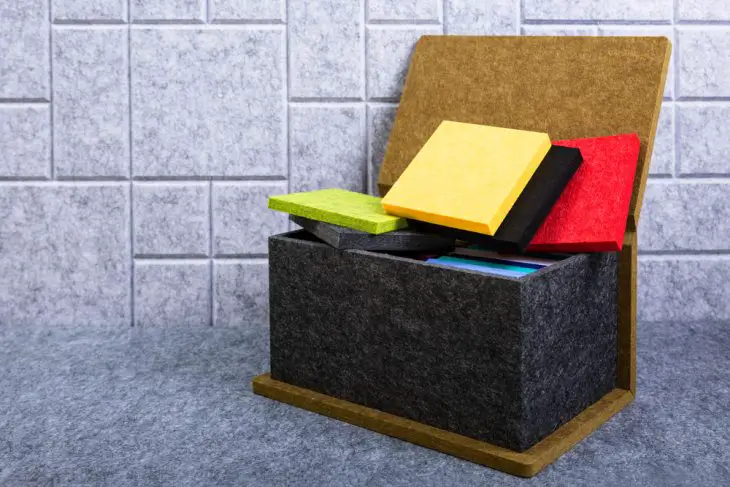Soundproofing may seem like a daunting task. However, it doesn’t have to be. There are a few simple ways to break it down and dismantle the complexity piece by piece.

There are many different reasons why you may wish to soundproof something from avoiding noisy neighbors to recording audio and video undisturbed and many in between. So how do you soundproof a box?
In this article, we will explore the methods you could use to soundproof a box.
We will look at how sound works, what materials you can use to soundproof and create a simple guide to achieving your soundproofing goals. By the end, you will know how to easily soundproof a box.
Table of Contents
What Is Sound?
Sound is a type of energy. The energy manifest through vibration. The vibration creates waves, big and small, that in turn travel through the air around us.
The waves can also travel through solid objects such as walls, or water. These waves eventually reach our ears.
This process happens very quickly. The closer you are to the source of vibration, the louder you will receive the sound. It stands to reason that, the goal is to make the vibrations further away.
The further away you are, the quieter the sound. The more things blocking the vibrations, the quieter the sound.
So, in order to make something soundproof, we need to find a way to block those soundwaves or, absorb them into something else.
Materials Used For Soundproofing
There are a range of suitable options for soundproofing materials. There’s no need to think too high-spec or technical.
You can use a selection of things that are cost-friendly and widely available. Listed below are some easily obtainable sources you can soundproof a box with.
- -Foam: Soft and lightweight, foam acts as a natural absorber of sound. It is spongey by nature and therefore, sound waves are trapped inside the small and flexible particles. Foam is a good option for smaller, sound-proofing projects. It is not hardy enough to soundproof anything larger, and won’t be 100% effective when trapping noise.
- -Rubber: Rubber and rubber mats are a popular choice in the homemade soundproofing arena. Rubber is low enough in price, you won’t need a large quantity, and absorbs more soundwaves than foam.
- -Fibreglass: Fibreglass comes out top of the list when it comes to soundproofing. You can use fiberglass on bigger projects and across a range of things, even walls if required. Fiberglass is made from heating up and breaking down the glass. It is thick and when used correctly, can be really efficient at absorbing noise.
Soundproofing A Box In Four Simple Steps
TOP TIP: If you are struggling to find foam or rubber, any thick and dense material will work. For example, an offcut of carpet. The key is density. If the material is dense, it will absorb noise in the same way as foam and rubber.
- Choose your material. And choose it wisely. There are a number of different choices when it comes to simple soundproofing. Some are more effective than others. For a bog standard atypical cardboard box, foam and/or rubber will be more than sufficient. You can also use styrofoam, carpet offcuts, old rugs, thick clothes, you got it. Make sure you measure the area of your box properly, then purchase or acquire the correlating amount of material.
Remember you will also need scissors, tape, and some form of adhesive substance such as glue or spray glue. These are for adjusting the shape of the material and sticking it in place.
- Insulate, insulate, insulate! This is the fun part. Take your material and start cutting to shape. Layers of smaller thickness are a good method to start with. Cover the complete interior of your box. Make sure that any gaps and holes are covered with tape and by a material of some sort. This will make sure that there are no gaps for the sound to escape through or into.
After the interior is sorted, allow time to also cover the exterior of the box. Remember, no gaps or holes can be left showing. Every millimeter must be accounted for. When this is all finished, you can move on to the testing stage.
- Test and adjust. After every crevice is covered, now is the time to test. Do your test, and if it’s not quite right or soundproofed to your expectation, it’s time to add more material. Using a combination of materials may be your next step. For example, styrofoam along the interior of a box combined with carpet on the outside is a solid soundproofing combination.
- Tweak and test. Tweak and test until your box is as soundproof as you require. If you find one material hasn’t quite worked, there are plenty of others to try out too. Finding something that works how you want it to might take a few attempts.
Mythbuster
Can you use an egg box to soundproof? Yes, but not very effectively. Egg boxes, owing to their unique shape, deflect sound and deter the waves from reverbing off the surface.
However, they are not very dense, instead of being light and flimsy. So, it would take a large amount of egg box cartons to come close to something seriously soundproofed!
Using egg boxes to soundproof would be a fun activity with children but, not for anything more serious.
Final Thoughts
So now you know how sound works, how to stop it in its tracks, and how to choose the best tools to do so. Soundproofing doesn’t have to be flashy and expensive.
You can use dense materials that will act to catch the sound. You could even use egg box cartons, though results may vary.
There are economical and time-saving ways to soundproof a box at home and, you don’t need to be a professional acoustician to do so.
Foam, rubber, and carpet are dependable soundproofing materials and can be sourced rapidly, cheaply, and easily.
